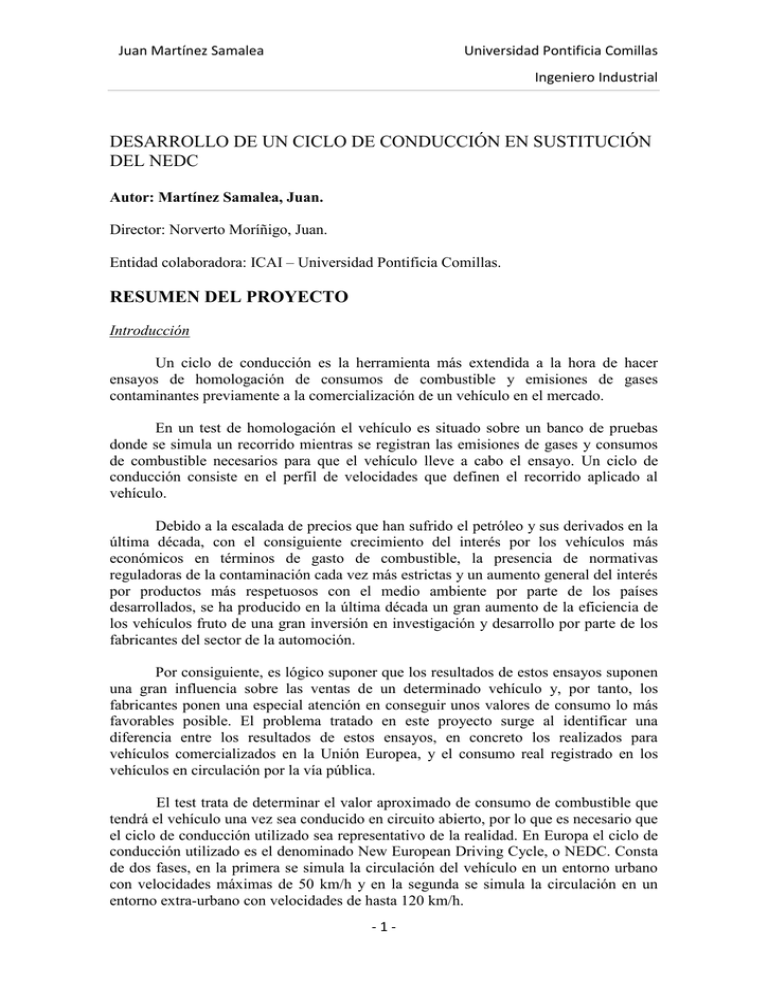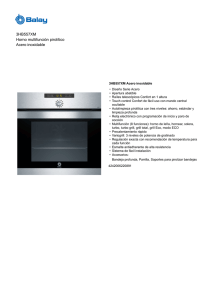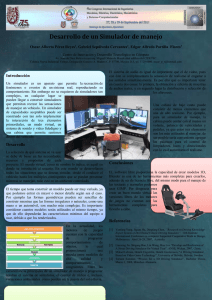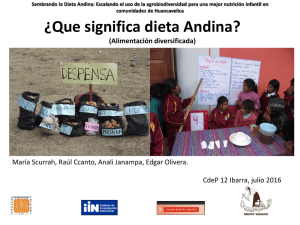desarrollo de un ciclo de conducción en sustitución del nedc
Anuncio

Juan Martínez Samalea Universidad Pontificia Comillas Ingeniero Industrial DESARROLLO DE UN CICLO DE CONDUCCIÓN EN SUSTITUCIÓN DEL NEDC Autor: Martínez Samalea, Juan. Director: Norverto Moríñigo, Juan. Entidad colaboradora: ICAI – Universidad Pontificia Comillas. RESUMEN DEL PROYECTO Introducción Un ciclo de conducción es la herramienta más extendida a la hora de hacer ensayos de homologación de consumos de combustible y emisiones de gases contaminantes previamente a la comercialización de un vehículo en el mercado. En un test de homologación el vehículo es situado sobre un banco de pruebas donde se simula un recorrido mientras se registran las emisiones de gases y consumos de combustible necesarios para que el vehículo lleve a cabo el ensayo. Un ciclo de conducción consiste en el perfil de velocidades que definen el recorrido aplicado al vehículo. Debido a la escalada de precios que han sufrido el petróleo y sus derivados en la última década, con el consiguiente crecimiento del interés por los vehículos más económicos en términos de gasto de combustible, la presencia de normativas reguladoras de la contaminación cada vez más estrictas y un aumento general del interés por productos más respetuosos con el medio ambiente por parte de los países desarrollados, se ha producido en la última década un gran aumento de la eficiencia de los vehículos fruto de una gran inversión en investigación y desarrollo por parte de los fabricantes del sector de la automoción. Por consiguiente, es lógico suponer que los resultados de estos ensayos suponen una gran influencia sobre las ventas de un determinado vehículo y, por tanto, los fabricantes ponen una especial atención en conseguir unos valores de consumo lo más favorables posible. El problema tratado en este proyecto surge al identificar una diferencia entre los resultados de estos ensayos, en concreto los realizados para vehículos comercializados en la Unión Europea, y el consumo real registrado en los vehículos en circulación por la vía pública. El test trata de determinar el valor aproximado de consumo de combustible que tendrá el vehículo una vez sea conducido en circuito abierto, por lo que es necesario que el ciclo de conducción utilizado sea representativo de la realidad. En Europa el ciclo de conducción utilizado es el denominado New European Driving Cycle, o NEDC. Consta de dos fases, en la primera se simula la circulación del vehículo en un entorno urbano con velocidades máximas de 50 km/h y en la segunda se simula la circulación en un entorno extra-urbano con velocidades de hasta 120 km/h. -1- Juan Martínez Samalea Universidad Pontificia Comillas Ingeniero Industrial La figura 1 muestra el perfil de velocidades que caracteriza a este ciclo de conducción. Figura 1. Perfil de velocidades del ciclo NEDC. El objeto de este proyecto es proponer un ciclo de conducción alternativo al ciclo NEDC con el fin de conseguir unos resultados más cercanos a la realidad en los ensayos de homologación de consumos de combustible y emisiones de gases. Metodología En primer lugar es necesario elaborar un simulador donde poder reproducir el comportamiento de un vehículo al llevar a cabo el ciclo de conducción y obtener una estimación precisa de los resultados sin necesidad de realizar empíricamente los ensayos. El desarrollo del simulador se ha llevado a cabo haciendo uso de las aplicaciones informáticas Matlab y Simulink. Una vez concluida la elaboración del simulador se ha comprobado su precisión simulando el ciclo NEDC, cuyos resultados son conocidos. En esta simulación se ha obtenido una desviación en el consumo entregado por el simulador respecto del consumo declarado por el fabricante inferior al 3%, lo que ratifica la exactitud de la información ofrecida por el simulador. Para poder construir el ciclo de conducción de manera que represente fielmente la realidad se han realizado mediciones empíricas en circuito abierto en las que se ha registrado los valores de velocidades de un vehículo en multitud de escenarios diferentes. Estas medidas se pueden agrupar en tres categorías: circulación por vía urbana, circulación por la red de carreteras secundarias y circulación por la red de -2- Juan Martínez Samalea Universidad Pontificia Comillas Ingeniero Industrial autopistas y autovías. El análisis de los datos registrados aporta las pautas necesarias que debe seguir el ciclo de conducción propuesto. Una vez finalizadas las medidas empíricas se ha procedido al procesamiento de los datos obtenidos y a su implantación en el entorno de simulación. Tras realizar las simulaciones de estos datos para calcular el consumo del vehículo en circunstancias reales, se ha llevado a cabo el desarrollo del ciclo de conducción alternativo al NEDC, cuyo perfil de velocidades se muestra en la figura 2. Figura 2. Ciclo de conducción propuesto como alternativa al NEDC. Resultados La tabla 1 muestra los resultados obtenidos por las simulaciones de las medidas tomadas empíricamente y del ciclo propuesto en comparación con los valores ofrecidos por el ciclo NEDC para un Volkswagen Golf 2.0 TDI 140 cv con cambio manual. -3- Juan Martínez Samalea Universidad Pontificia Comillas Ingeniero Industrial Circulación Consumo medido en el test NEDC Consumo simulado en las medidas experimentales Consumo simulado en el ciclo de conducción propuesto Urbana 7,1 l/100km 7,02 l/100km 7,18 l/100 km Vías secundarias 4,5 l/100km 6,48 l/100km 6,67 l/100 km Autopista 4,5 l/100km 5,64 l/100km 5,87 l/100 km Combinada 5,3 l/100km 6,21 l/100km 6,12 l/100 km Tabla 1. Resultados de las simulaciones de los distintos ciclos. Como puede observarse en la tabla 1, los resultados obtenidos en las simulaciones realizadas con el ciclo de conducción alternativo suponen una buena representación de los obtenidos en las simulaciones de las medidas tomadas experimentalmente, con márgenes de error inferiores al 5%. Por el contrario, el ciclo NEDC ofrece unos valores de consumo que, fundamentalmente en los casos de circulación extra-urbana, se sitúan muy por debajo de los valores de consumo del vehículo en carretera abierta, con errores de hasta un 30% del valor. Si se comparan estos valores con una base de datos existente en la que usuarios de distintos vehículos almacenan sus registros reales de consumo de combustible se obtienen unos resultados similares. La siguiente figura muestra una comparación entre los consumos homologados según el ciclo NEDC, los simulados utilizando el ciclo de conducción propuesto y la media de consumo registrada en la base de datos de consumo para una serie de vehículos diferentes. Consumo declarado por el ciclo NEDC [l/100km] Consumo real registrado [l/100 km] Consumo simulado mediante el ciclo propuesto [l/100 km] 5,3 6,03 6,12 5,8 6,57 6,67 6 6,98 7,17 Audi A3 5,5 6,32 6,55 Audi A4 5,8 6,65 6,77 Audi A6 6,1 7,76 7,25 Vehículo Volkswagen Golf Volkswagen Passat Volkswagen Touran Tabla 2. Consumos de combustible obtenidos según el ciclo NEDC, la base de datos de consumo y el ciclo alternativo propuesto. -4- Juan Martínez Samalea Universidad Pontificia Comillas Ingeniero Industrial Figura 3. Consumos de combustible obtenidos según el ciclo NEDC, la base de datos de consumo y el ciclo alternativo propuesto. En la figura 3 se puede apreciar cómo el consumo medido en la simulación del ciclo propuesto se ajusta con gran precisión al consumo real del vehículo aportado por la base de datos, mientras que el consumo homologado por el ciclo NEDC se encuentra en todo momento con valores entre un 15% y un 25% inferiores a los de consumo real. Conclusiones Basándose en los resultados de las simulaciones realizadas se puede afirmar que el ciclo NEDC no resulta representativo del comportamiento real de un vehículo y, por tanto, no resulta apropiado para la realización de ensayos de homologación de consumos de combustible y emisiones contaminantes. Por otra parte, se ha comprobado cómo el ciclo propuesto sí que se ajusta al comportamiento real del vehículo, con unos márgenes de error muy inferiores a los que presenta el ciclo NEDC, por lo que puede considerarse una alternativa real al empleo de este último a la hora de realizar los ensayos de homologaciones. Por último, cabe destacar la precisión del simulador elaborado, que lo convierte en una herramienta idónea para estimar el consumo de un vehículo, y cuyo futuro desarrollo podría favorecer su uso en otras aplicaciones referentes al comportamiento dinámico de un automóvil. -5- Juan Martínez Samalea Universidad Pontificia Comillas Ingeniero Industrial -6- Juan Martínez Samalea Universidad Pontificia Comillas Ingeniero Industrial DEVELOPMENT OF A DRIVING CYCLE IN REPLACEMENT FOR THE NEDC. PROJECT SUMMARY Introduction A driving cycle is the most extended tool for performing fuel consumption and emission levels official approval tests prior to the launch of a new vehicle into a market. In these tests the vehicle is placed on a test bench in which it is performed a simulation of an itinerary. During the test the emissions and fuel consumption needed to complete the itinerary are measured. A driving cycle consists of the speed profile that defines this itinerary. Due to the risen on the prices of oil and its derived products, during the last decade there has been an increase on the interest for more and more economic vehicles in terms of fuel efficiency. In addition, the adoption of new and stricter emissions regulations and the increasing interest on environment-friendly products in the developed countries has benefited a great progress on vehicles fuel efficiency as a result of a strong investment on research and development carried out by the automotive manufacturers. Thus, the results obtained in these tests have a considerable impact on vehicles’ sales and, therefore, car manufacturers will put a substantial effort on achieving as lowest fuel consumption values as possible. However, there are cases in which the result of the test doesn’t correlate with the fuel consumption of the vehicle when it is driven in open road, especially in those tests performed for vehicles sold in the European Union. This is problem intended to solve in this project. The test tries to give an approximate value of the fuel consumption of the vehicle in open road, so the driving cycle used must be appropriately representative of the population’s driving habits. The driving cycle used within the European Union is the New European Driving Cycle, or NEDC. It consists of two stages: the first one simulates urban driving, with speeds up to 50 km/h, and the second one simulates extraurban driving, with a top speed of 120 km/h. Figure 1 shows the speed profile that defines the NEDC cycle. -7- Juan Martínez Samalea Universidad Pontificia Comillas Ingeniero Industrial Figure 1. NEDC cycle speed profile. The main objective of this project is to suggest and develop a driving cycle in replacement for the NEDC so that the results obtained in the test on fuel consumption and emission levels are closer to reality Methodology The first step is to develop a software application capable of simulating the dynamics of a vehicle when carrying out a driving cycle, so that an estimation of the fuel consumption may be calculated without the need of performing empirical tests. The simulator has been developed using the software Matlab and its application Simulink. Once the simulator has been built, its accuracy has been tested by simulating an NEDC driving cycle. The results for this test are known, as they are the ones provided by the car manufacturer. In this simulation, using as the vehicle a manual Volkswagen Golf 2.0 TDI, the results offered by the simulator showed a deviation of less than 3% with the ones offered by the NEDC cycle, which certifies its precision. In order to develop the driving cycle so that it represents accurately the real consumption there has been carried out empiric measurements on open road in which there has been registered speed data while driving a vehicle on different scenarios. These measurements can be put into three categories: urban driving, secondary roads driving and highway driving. The analysis of the data gathered in these measurements will provide the main guidelines for the establishment of the alternative driving cycle. -8- Juan Martínez Samalea Universidad Pontificia Comillas Ingeniero Industrial The next step consists of processing the data measured and implementing it into the simulation environment. Then, a simulation of this data is performed, which returns the fuel consumption simulated on real driving conditions instead of on a driving cycle. After carrying out these simulations and analyzing their results there has been developed the driving cycle which intends to be a substitute to the NEDC cycle. Figure 2 shows the speed profile for this proposed driving cycle. Figure 2. Proposed driving cycle as an alternative to the NEDC. Results Table 1 shows the results obtained in the simulations of the empirical measures and the proposed driving cycle, compared to the values of the fuel consumption given by the NEDC test. -9- Juan Martínez Samalea Universidad Pontificia Comillas Ingeniero Industrial Road NEDC consumption Empirical measures consumption simulation Urban 7,1 l/100km 7,02 l/100km 7,18 l/100 km Secondary roads 4,5 l/100km 6,48 l/100km 6,67 l/100 km Highway 4,5 l/100km 5,64 l/100km 5,87 l/100 km Combination 5,3 l/100km 6,21 l/100km 6,12 l/100 km Proposed driving cycle simulation Table 1. Simulations results compared to the NEDC test results. As it may be observed, the results offered by the simulation of the proposed driving cycle suppose a good representation of the ones offered by the empirical measures, with a margin of error lower than 5%. However, the fuel consumption values offered by the NEDC test, especially in extra-urban driving, are considerably lower than the empirical ones, presenting a margin of error of up to 30% of the value. These results can also be compared to an existing database that stores the real, open road measured fuel consumption records of its users, with similar outcome than in the previous comparison. Table 2 shows a comparison of the NEDC tests, the mean fuel consumption of the users in the database and the simulation of the proposed cycle for six different vehicles. NEDC fuel consumption [l/100km] Real fuel consumption recorded in the database [l/100 km] Simulation of the proposed driving cycle [l/100 km] 5,3 6,03 6,12 5,8 6,57 6,67 6 6,98 7,17 Audi A3 5,5 6,32 6,55 Audi A4 5,8 6,65 6,77 Audi A6 6,1 7,76 7,25 Vehicle Volkswagen Golf Volkswagen Passat Volkswagen Touran Table 2. Fuel consumption results for the NEDC cycle, consumption database information and simulation of the proposed driving cycle. - 10 - Juan Martínez Samalea Universidad Pontificia Comillas Ingeniero Industrial 8 7,5 7 Consumo declarado por el ciclo NEDC [l/100km] 6,5 6 5,5 Consumo real registrado [l/100 km] 5 4,5 Consumo simulado mediante el ciclo propuesto [l/100 km] 4 Figure 3. Fuel consumption results for the NEDC cycle, consumption database information and simulation of the proposed driving cycle. As it may be observed in figure 3, the proposed driving cycle results provide a high accuracy to the real values obtained from the database, whereas the consumption declared by the NEDC cycle remains in all cases in values about 15% to 25% lower than the real fuel consumption ones. Conclusions Based on the results of the simulations carried out it may be confirmed that the NEDC cycle is not representative of the real behavior of a vehicle, and therefore its use is not appropriate for the execution of official approval tests for the measurement of fuel consumption and emission levels. Also, it has been proved how the proposed cycle actually adapts with high precision to the real behavior of a vehicle, with margins of error much lower than the ones present in the NEDC tests. Thus, the proposed cycle may be considered as an alternative to the NEDC cycle for the development of these tests. Finally, it needs to be noted the accuracy of the simulator developed, making it an ideal tool for estimating fuel consumption of a vehicle, and whose future development may favor its use in other applications concerning the dynamic behavior of a car. - 11 -


